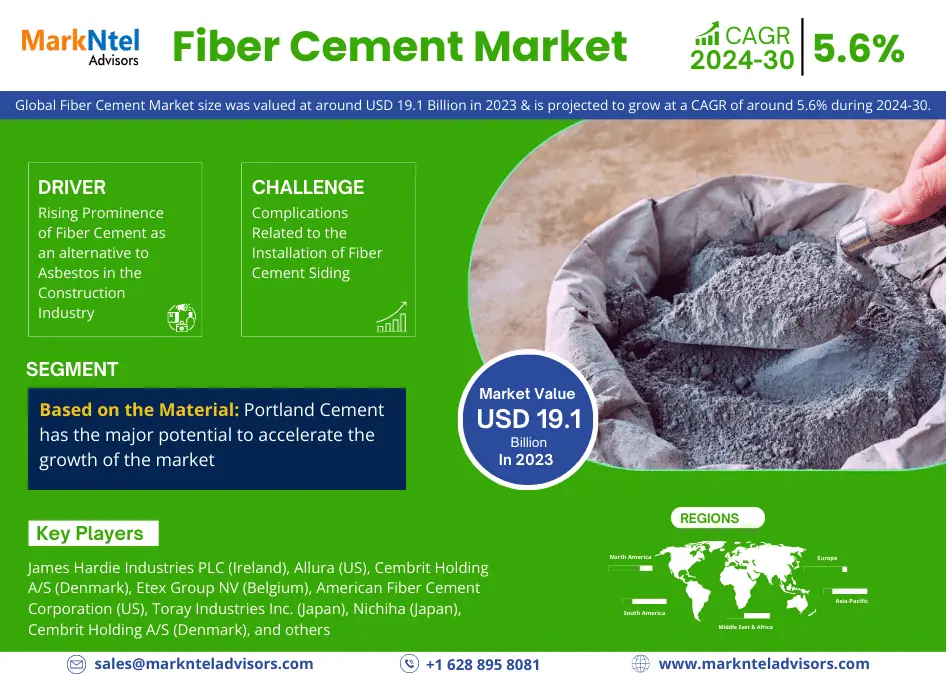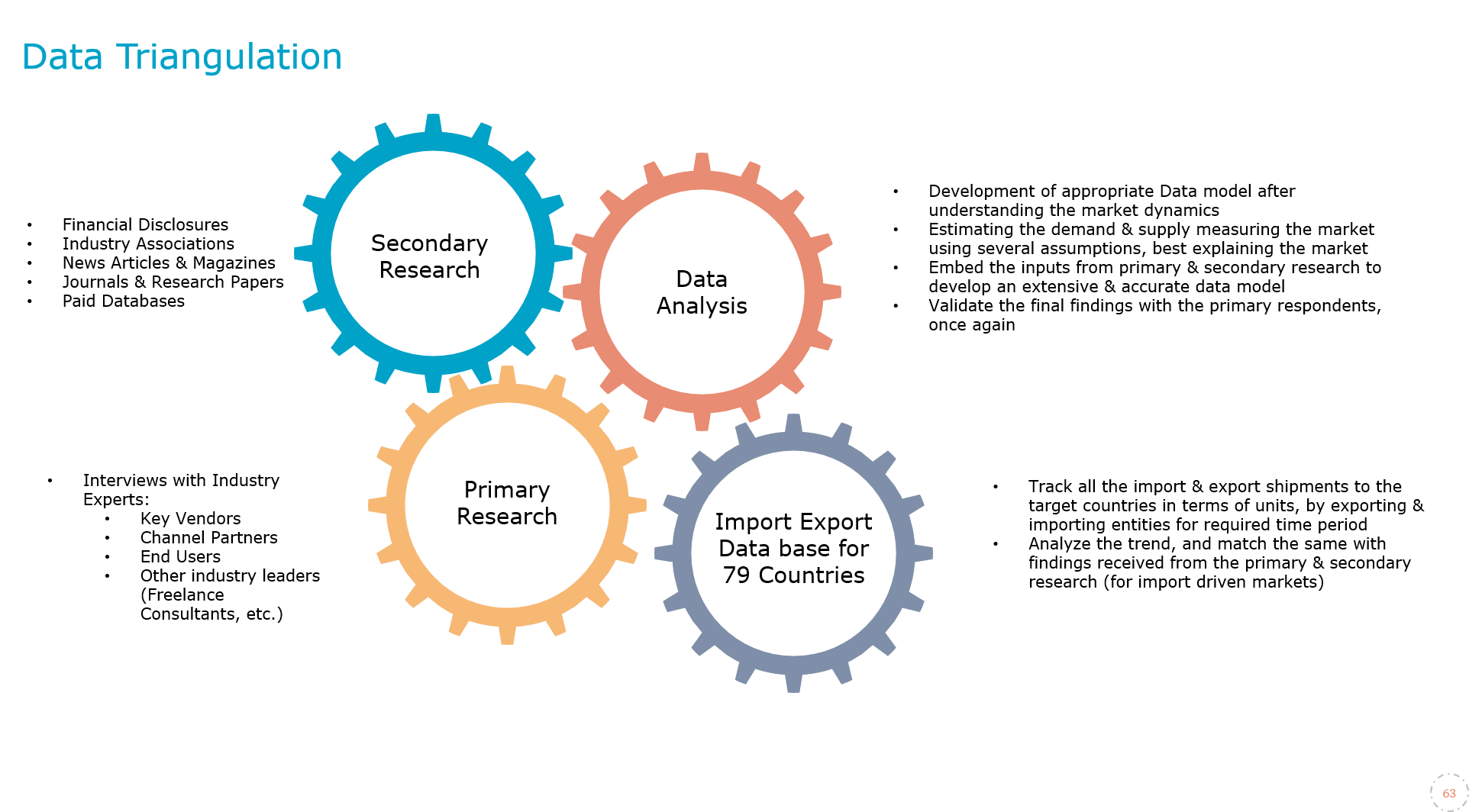
Global Fiber Cement Market Research Report: Forecast (2024-2030)
Fiber Cement Market - By Material (Cellulosic material, Portland cement, Sand), By Application (Cladding, Roofing, Siding, Molding & Trimming, Backer Boards, Wall Partition, Others...), By End-User (Residential, Non-Residential), By Fiber Type (Polypropylene, PVA, Lignocellulose, Carbon, Others), By Production Process (Hatschek Process, Extrusion Process, Perlite Process), and others Read more
- Buildings, Construction, Metals & Mining
- Apr 2023
- Pages 197
- Report Format: PDF, Excel, PPT
Market Definition
Fiber cement is a composite construction material also acknowledged as reinforced fiber cement and is used mainly in roofing & facade works due to its strength & durability. It has several different benefits, including its low cost, fire resistance, water tightness, lightweight, and termite resistance. These properties of such products are easy to work with and low maintenance, making them the ideal choice for professional builders, designers, & architects. In addition, it is fungi, mold, and bacteria resistant, owing to its durability and ability to be disposed of in landfills. Due to these factors, Fiber cement is claimed to be an extraordinary material being non-vulnerable to the environment.
Market Insights & Analysis: Global Fiber Cement Market (2024-30)
The Global Fiber Cement Market size was valued at around USD 19.1 Billion in 2023 and is projected to grow at a CAGR of around 5.6% during the forecast period, i.e., 2024-30. The market is primarily influenced by many advantageous factors, including developing countries getting more exposure to rapidly strengthening urbanization and industrialization. Other than this, the rising demand for eco-friendly material in the construction industry, the non-vulnerability and high durability of fibers, and the ban on asbestos cement products are anticipated to encourage the adoption of fiber cement for building and construction in the long run. As a result, these materials are used widely in several applications, including roofing, cladding, and building facades across both residential & non-residential sectors.
| Report Coverage | Details |
|---|---|
| Study Period | Historical Data: 2019-22 |
| Base Year: 2023 | |
| Forecast Period: 2024-30 | |
| CAGR (2024-2030) | 5.6% |
| Regions Covered | North America: US, Canada, Mexico |
| Europe: Germany, UK, France, Italy | |
| Asia-Pacific: China, India, Japan, South Korea | |
| South America: Brazil, Argentina | |
| Middle East & Africa: Saudi Arabia, South Africa, Rest of the Middle East & Africa | |
| Key Companies Profiled | James Hardie Industries PLC (Ireland), Allura (US), Cembrit Holding A/S (Denmark), Etex Group NV (Belgium), American Fiber Cement Corporation (US), Toray Industries Inc. (Japan), Nichiha (Japan), Cembrit Holding A/S (Denmark), CSR Limited (Australia), Elementia |
| Market Value (2023) | USD 19.1 Billion |
Moreover, the surging demand for high diversification in product offerings and the adoption of advanced technologies will offer lucrative growth opportunities for the market in the forthcoming period. However, the need for more skilled labor and the complex procedure of installing products made using such kinds of cement are some prominent factors likely to limit the expansion of the Global Fiber Cement Market during 2024-30.
Global Fiber Cement Market Driver:
Rising Prominence of Fiber Cement as an alternative to Asbestos in the Construction Industry - One of the significant key drivers responsible for the expansion of the market includes the rising prominence of fiber cement in the construction industry. Undoubtedly, the product has plenty of benefits to offer to its end users, and the market is projected to follow the footprints of success during 2024-2030. The growth can be attributed to the ban imposed on asbestos cement products. The International Ban Asbestos Secretariat (IBAS) reports that over 60 countries have enacted complete bans on Asbestos due to its well-known health and safety risks.
Since they are often used for residential construction for rooftop extensions, storage rooms, cottages, farmhouses, site offices, and so on, manufacturers have turned their focus to fiber cement as an alternative to Asbestos, citing their functional similarity. Moreover, due to its extended life, versatility, and attractiveness, paired with its remarkable resistance to fire, weather, warping, and rotting, the product has gained popularity in the construction industry. Such tremendous factors are urging the market to expand exponentially during the projected period.
Global Fiber Cement Market Possible Restraint:
Complications Related to the Installation of Fiber Cement Siding - The shortage of skilled labor and the complex procedure of installing products made using fiber cement are some prominent factors that might hinder the growth of the Global Fiber Cement Market during 2024-30. Therefore, a vast understanding of the several nails and guns used in the installation procedure must be improved.
Moreover, it might adversely affect an individual since cutting the sides and edges of the cement emits crystalline silica, which is a harmful human carcinogen. When crystalline silica gets excessively emitted into the air, it enlarges the risk of silicosis, lung cancer, and chronic obstructive pulmonary disease (COPD). Hence, the harmful effects of installing fiber cement necessitate skilled labor, and the lack of it may cause market growth obstacles during the forecast period.

Global Fiber Cement Market (2024-30): Segmentation Analysis
The Global Fiber Cement Market study of MarkNtel Advisors evaluates & highlights the major trends & influencing factors in each segment & includes predictions for the period 2024–2030 at the global, regional, and national levels. Based on the analysis, the market has been further classified as:
Based on the Application,
- Cladding
- Roofing
- Siding
- Molding & Trimming
- Backer Boards
- Wall Partition
Here, Siding is one of the significant applications of fiber cement. With a rapid surge in the construction of residential & non-residential buildings, the demand for such materials in Siding applications is increasing substantially. In addition, the rising inclination for green buildings, coupled with the need for style, durability, & affordability, is also contributing to the increasing adoption of such products for construction purposes and will drive the market during the projected period.
Along with this, molding & trimming is the fastest-growing application in the market due to the increasing installation of trim boards in housing projects, coupled with its superior performance attributes, including low maintenance requirements, the ability to withstand harsh weather conditions without rotting, and fireproof characteristics. In addition, fiber cement moldings & trims are used primarily in exterior applications. Hence, these aspects are propelling the use of such types of products for molding & trimming applications, thereby contributing to the overall market growth.
Based on the Material,
- Cellulosic Material
- Portland Cement
- Sand
Of these, Portland Cement has the major potential to accelerate the growth of the market. Even during the historical period, it dominated as the leading material segment of the market due to its production via mixing calcium, silica, iron, aluminum, and other essential additives. Portland Cement is classified under Ordinary Portland Cement (OPC) and White Portland Cement. Its low maintenance and production cost, simplest raw materials, including limestone, naturally occurring minerals, and shale used for the production, are the significant variables that will unquestionably change the entire market paradigm in a progressing way.
Global Fiber Cement Market Regional Projection:
Geographically, the Global Market expands across:
- North America
- South America
- Europe
- Middle East & Africa
- Asia-Pacific
Geographically, of all regions, Asia-Pacific holds the largest share of the Fiber Cement Market, mainly because it is the fastest-growing economy worldwide, creating the massive potential for infrastructural developments. Moreover, the booming construction industry in India & China, substantial investments in infrastructural developments, and mounting awareness regarding the harmful impact of using asbestos are other crucial factors driving the demand for these products in Asia-Pacific.
Additionally, stringent norms regarding using asbestos cement in construction activities have shifted builders & related authorities towards using alternatives.
Further, Europe is anticipated to witness the fastest market growth during the forecast period, mainly due to the mounting trend of constructing energy-efficient buildings. Additionally, surging European residential constructions are fueling market growth across the region.
Global Fiber Cement Industry Recent Developments:
- In March 2022, James Hardie Industries took a step further for its planned fiber cement capacity expansion by purchasing land in Melbourne, Victoria. The company plans to add a fiber cement manufacturing site in the State of Victoria to support the strong demand for high-value building solutions in the Asia Pacific region.
- In January 2022, Swisspearl Group AG successfully positioned itself as Europe's second-largest fiber cement manufacturer after purchasing its biggest rival, Denmark's fiber cement major, Cembrit. With this purchase, Swisspearl Group could strengthen its global reach and find new target markets.
Gain a Competitive Edge with Our Global Fiber Cement Market Report
- Global Fiber Cement Market report provides a detailed and thorough analysis of market size, growth rate, competitive landscape, and key players. This comprehensive analysis helps businesses gain a holistic understanding of the market dynamics and make informed decisions.
- This report also highlights current market trends and future projections, allowing businesses to identify emerging opportunities and potential challenges. By understanding market forecasts, companies can align their strategies and stay ahead of the competition.
- Global Fiber Cement Market report aids in assessing and mitigating risks associated with entering or operating in the market.
- The report would help in understanding market dynamics, regulatory frameworks, and potential challenges, businesses can develop strategies to minimize risks and optimize their operations.
Frequently Asked Questions
Global Fiber Cement Market Research Report (2024-2030) - Table of Contents
- Introduction
- Product Definition
- Research Process
- Market Segmentation
- Assumptions
- Preface
- Executive Summary
- Impact of COVID-19 on Global Fiber Cement Market
- Global Fiber Cement Market Dynamics
- Growth Drivers
- Challenges
- Impact Analysis
- Global Fiber Cement Market Policies and Product Standards
- Global Fiber Cement Market Trends & Insights
- Global Fiber Cement Market Hotspot & Opportunities
- Global Fiber Cement Market Key Strategic Imperatives for Success & Growth
- Global Fiber Cement Market Analysis, 2019- 2030F
- Market Size & Analysis
- By Value
- By Volume
- Market Size & Analysis
- Market Share & Analysis
- By Material
- Cellulosic Material
- Portland Cement
- Sand
- By Application
- Cladding
- Roofing
- Siding
- Molding & Trimming
- Backer Boards
- Wall Partition
- Others
- By End-Users
- Residential
- Non-Residential
- By Fiber Type
- Polypropylene
- PVA
- Lignocellulose
- Carbon
- Others
- By Production Process
- Hatschek Process
- Extrusion Process
- Perlite Process
- By Region
- North America
- Europe
- Asia-Pacific
- South America
- Middle East & Africa
- By Company
- Competition Characteristics
- Market Share & Analysis
- Competitive Matrix
- By Material
- North America Fiber Cement Market Outlook, 2019-2030F
- Market Size & Analysis
- By Value
- By Volume
- Market Share & Analysis
- By Material
- By Application
- By End-Users
- By Fiber Type
- By Production Process
- By Country
- The US
- Canada
- Mexico
- The US Fiber Cement Market Outlook, 2019-2030F
- Market Size & Analysis
- By Value
- By Volume
- Market Share & Analysis
- By Material
- By Application
- By End-Users
- By Fiber Type
- By Production Process
- Market Size & Analysis
- Canada Fiber Cement Market Outlook, 2019-2030F
- Market Size & Analysis
- By Value
- By Volume
- Market Share & Analysis
- By Material
- By Application
- By End-Users
- By Fiber Type
- By Production Process
- Market Size & Analysis
- The Mexico Fiber Cement Market Outlook, 2019-2030F
- Market Size & Analysis
- By Value
- By Volume
- Market Share & Analysis
- By Material
- By Application
- By End-Users
- By Fiber Type
- By Production Process
- Market Size & Analysis
- Market Size & Analysis
- South America Fiber Cement Market Outlook, 2019-2030F
- Market Size & Analysis
- By Value
- By Volume
- Market Share & Analysis
- By Material
- By Application
- By End-Users
- By Fiber Type
- By Production Process
- By Country
- Brazil
- Argentina
- Brazil Fiber Cement Market Outlook, 2019-2030F
- Market Size & Analysis
- By Value
- By Volume
- Market Share & Analysis
- By Material
- By Application
- By End-Users
- By Fiber Type
- By Production Process
- Market Size & Analysis
- Argentina Fiber Cement Market Outlook, 2019-2030F
- Market Size & Analysis
- By Value
- By Volume
- Market Share & Analysis
- By Material
- By Application
- By End-Users
- By Fiber Type
- By Production Process
- Market Size & Analysis
- Market Size & Analysis
- Europe Fiber Cement Market Outlook, 2019-2030F
- Market Size & Analysis
- By Value
- By Volume
- Market Share & Analysis
- By Material
- By Application
- By End-Users
- By Fiber Type
- By Production Process
- By Country
- The UK
- Italy
- Germany
- France
- Others
- The UK Fiber Cement Market Outlook, 2019-2030F
- Market Size & Analysis
- By Value
- By Volume
- Market Share & Analysis
- By Material
- By Application
- By End-Users
- By Fiber Type
- By Production Process
- Market Size & Analysis
- Italy Fiber Cement Market Outlook, 2019-2030F
- Market Size & Analysis
- By Value
- By Volume
- Market Share & Analysis
- By Material
- By Application
- By End-Users
- By Fiber Type
- By Production Process
- Market Size & Analysis
- Germany Fiber Cement Market Outlook, 2019-2030F
- Market Size & Analysis
- By Value
- By Volume
- Market Share & Analysis
- By Material
- By Application
- By End-Users
- By Fiber Type
- By Production Process
- Market Size & Analysis
- France Fiber Cement Market Outlook, 2019-2030F
- Market Size & Analysis
- By Value
- By Volume
- Market Share & Analysis
- By Material
- By Application
- By End-Users
- By Fiber Type
- By Production Process
- Market Size & Analysis
- Market Size & Analysis
- Middle East & Africa Fiber Cement Market Outlook, 2019-2030F
- Market Size & Analysis
- By Value
- By Volume
- Market Share & Analysis
- By Material
- By Application
- By End-Users
- By Fiber Type
- By Production Process
- By Country
- Saudi Arabia
- South Africa
- Rest of the Middle East & Africa
- Saudi Arabia Fiber Cement Market Outlook, 2019-2030F
- Market Size & Analysis
- By Value
- By Volume
- Market Share & Analysis
- By Material
- By Application
- By End-Users
- By Fiber Type
- By Production Process
- Market Size & Analysis
- South Africa Fiber Cement Market Outlook, 2019-2030F
- Market Size & Analysis
- By Value
- By Volume
- Market Share & Analysis
- By Material
- By Application
- By End-Users
- By Fiber Type
- By Production Process
- Market Size & Analysis
- Market Size & Analysis
- Asia-Pacific Fiber Cement Market Outlook, 2019-2030F
- Market Size & Analysis
- By Value
- By Volume
- Market Share & Analysis
- By Material
- By Application
- By End-Users
- By Fiber Type
- By Production Process
- By Country
- China
- Japan
- India
- South Korea
- Others
- China Fiber Cement Market Outlook, 2019-2030F
- Market Size & Analysis
- By Value
- By Volume
- Market Share & Analysis
- By Material
- By Application
- By End-Users
- By Fiber Type
- By Production Process
- Market Size & Analysis
- Japan Fiber Cement Market Outlook, 2019-2030F
- Market Size & Analysis
- By Value
- By Volume
- Market Share & Analysis
- By Material
- By Application
- By End-Users
- By Fiber Type
- By Production Process
- Market Size & Analysis
- India Fiber Cement Market Outlook, 2019-2030F
- Market Size & Analysis
- By Value
- By Volume
- Market Share & Analysis
- By Material
- By Application
- By End-Users
- By Fiber Type
- By Production Process
- Market Size & Analysis
- South Korea Fiber Cement Market Outlook, 2019-2030F
- Market Size & Analysis
- By Value
- By Volume
- Market Share & Analysis
- By Material
- By Application
- By End-Users
- By Fiber Type
- By Production Process
- Market Size & Analysis
- Market Size & Analysis
- Competition Outlook
- Competition Matrix
- Product/ Solution Portfolio
- Target Markets
- Target End Users
- Research & Development
- Strategic Alliances
- Strategic Initiatives
- Company Profiles of Top Companies (Business Description, Product Segments, Business Segments, Financials, Strategic Alliances/ Partnerships, Future Plans)
- James Hardie Industries PLC (Ireland)
- Allura (US)
- Cembrit Holding A/S (Denmark)
- Etex Group NV (Belgium)
- American Fiber Cement Corporation (US)
- Toray Industries Inc. (Japan)
- Nichiha (Japan)
- Cembrit Holding A/S (Denmark)
- CSR Limited (Australia)
- Elementia
- Competition Matrix
- Disclaimer
MarkNtel Advisors follows a robust and iterative research methodology designed to ensure maximum accuracy and minimize deviation in market estimates and forecasts. Our approach combines both bottom-up and top-down techniques to effectively segment and quantify various aspects of the market. A consistent feature across all our research reports is data triangulation, which examines the market from three distinct perspectives to validate findings. Key components of our research process include:
1. Scope & Research Design At the outset, MarkNtel Advisors define the research objectives and formulate pertinent questions. This phase involves determining the type of research—qualitative or quantitative—and designing a methodology that outlines data collection methods, target demographics, and analytical tools. They also establish timelines and budgets to ensure the research aligns with client goals.
2. Sample Selection and Data Collection In this stage, the firm identifies the target audience and determines the appropriate sample size to ensure representativeness. They employ various sampling methods, such as random or stratified sampling, based on the research objectives. Data collection is carried out using tools like surveys, interviews, and observations, ensuring the gathered data is reliable and relevant.
3. Data Analysis and Validation Once data is collected, MarkNtel Advisors undertake a rigorous analysis process. This includes cleaning the data to remove inconsistencies, employing statistical software for quantitative analysis, and thematic analysis for qualitative data. Validation steps are taken to ensure the accuracy and reliability of the findings, minimizing biases and errors.

4. Data Forecast and FinalizationThe final phase involves forecasting future market trends based on the analyzed data. MarkNtel Advisors utilize predictive modeling and time series analysis to anticipate market behaviors. The insights are then compiled into comprehensive reports, featuring visual aids like charts and graphs, and include strategic recommendations to inform client decision-making









